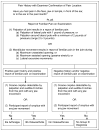Reliability and validity of Axis I of the Research Diagnostic Criteria for Temporomandibular Disorders (RDC/TMD) with proposed revisions
- PMID: 20663019
- PMCID: PMC3133763
- DOI: 10.1111/j.1365-2842.2010.02121.x
Reliability and validity of Axis I of the Research Diagnostic Criteria for Temporomandibular Disorders (RDC/TMD) with proposed revisions
Abstract
The research diagnostic criteria for temporomandibular disorders (RDC/TMD) have been employed internationally since 1992 for the study of temporomandibular muscle and joint disorders (TMD). This diagnostic protocol incorporates a dual system for assessment of TMD for Axis I physical diagnoses as well as Axis II psychological status and pain-related disability. Because the reliability and criterion validity of RDC/TMD had not yet been comprehensively characterised, the National Institute of Dental and Craniofacial Research funded in 2001 the most definitive research to date on the RDC/TMD as a U01 project entitled, 'Research Diagnostic Criteria: Reliability and Validity'. The results of this multi-site collaboration involving the University of Minnesota, the University of Washington, and the University at Buffalo were first reported at a pre-session workshop of the Toronto general session of the International Association of Dental Research on 2 July 2008. Summaries of five reports from this meeting are presented in this paper including: (i) reliability of RDC/TMD Axis I diagnoses based on clinical signs and symptoms; (ii) reliability of radiographic interpretations used for RDC/TMD Axis I diagnoses; (iii) reliability of self-report data used for RDC/TMD Axis I diagnoses; (iv) validity of RDC/TMD Axis I diagnoses based on clinical signs and symptoms; and (v) proposed revisions of the RDC/TMD Axis I diagnostic algorithms.
© 2010 Blackwell Publishing Ltd.
Figures



References
-
- Dworkin SF, LeResche L. Research diagnostic criteria for temporomandibular disorders: review, criteria, examinations and specifications, critique. J Craniofac Pain. 1992;6:301–355. - PubMed
-
- Smith TW. Measurement in health psychology research. In: Friedman HS, Silver RC, editors. Foundations of Health Psychology. New York: Oxford University Press; 2007. pp. 19–51.
-
- John MT, Dworkin SF, Mancl LA. Reliability of clinical temporomandibular disorder diagnoses. Pain. 2005;118:61–69. - PubMed
-
- Bossuyt PM, Reitsma JB, Bruns DE, Gatsonis CA, Glasziou PP, Irwig LM, et al. Standards for Reporting of Diagnostic Accuracy. Towards complete and accurate reporting of studies of diagnostic accuracy: the STARD initiative. Standards for reporting of diagnostic accuracy. Clin Chem. 2003;49:1–6. - PubMed
Publication types
MeSH terms
Grants and funding
LinkOut - more resources
Full Text Sources
Medical

